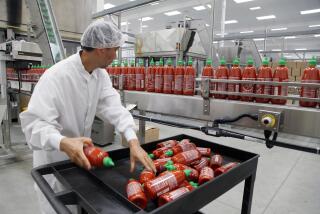Obscure metal at forefront of chip advance
- Share via
NEW YORK — Hafnium was known to hardly anyone outside a handful of scientists and engineers until late last month, when Intel Corp. and IBM Corp. announced a new class of faster, more efficient microprocessors that will use the silvery metal.
The stable and benign substance, listed No. 72 on the periodic table of elements, has made a breakthrough to the next generation of semiconductors possible, the companies said. They plan to make hafnium chips that could be designed into all manner of devices, including computer servers and cellphones.
Once the rare element becomes pervasive, is there a danger of supply shortages?
The question draws laughter from those in the know. Not in ridicule, but because the amount used is minuscule. Hafnium oxide will replace the layer of silicon oxide in tiny transistors that go into a chip. One chip requires hundreds of millions or even billions of transistors.
IBM Chief Technologist Bernard Meyerson put the supply situation in perspective: The hafnium in a cubic centimeter, the size of a small sugar cube, could be spread across 10 football fields’ worth of silicon wafers used to make chips.
“That assumes a 50-atom-high pile of it, which frankly would be an extraordinarily large amount,” he said. “That amount will go down over time.”
Hafnium oxide is an alloy, which means pure hafnium would stretch even further.
Electricity tends to leak out of transistor circuits because of their minute scale, resulting in power loss, and the silicon oxide material that hafnium replaces also leaks power. The new hafnium chips will help reduce that power loss and enable chipmakers to create smaller processors.
Each year, only 50 metric tons of hafnium is produced. It does not occur as a vein in the earth, so refiners must extract it as a byproduct of zirconium oxide, a fairly abundant metal prevalent in the U.S., Brazil, Australia, Russia and China.
Their nearly identical atomic structures render hafnium difficult and costly to separate from zirconium, and much depends on the zirconium deposit’s quality. About 60% to 70% of the world’s hafnium supply goes into nuclear control rods, with most of the remainder used in high-specification jet engine metals.
Industry observers were not fearful of competition for supplies, at least in the near term.
“Given the amounts we’re using, we’re not going to be fighting over sugar cubes,” IBM’s Meyerson said.
Still, according to American Elements of Los Angeles, a leading producer of rare-earth elements, hafnium’s presence in the Earth’s crust does not necessarily mean it’s minable.
American Elements President Michael Silver notes that radioactivity plagues deposits in Australia and that in Florida they are scattered in beach sand.
“In the Florida sands there’s a substantial amount of rare earth, but there’s no way in the world you’re going to be able to refine it. It would never be cost-effective,” he said.
American Elements, which makes about a metric ton of hafnium annually for customers such as General Electric Co., Siemens and the designers of the new chips, has been producing it for about 10 years at its facility in China, where most of the world’s minable supply exists.
An oft-cited quote by the late leader Deng Xiaoping, “The Middle East has oil and China has rare earth,” illustrates the Asian country’s proprietary view of its rare elements.
By imposing ever-stricter export restrictions, the Beijing government has been pressuring international firms to refine rare metals in China. Last month, Silver said, Beijing slapped a 10% export charge on rare-earth materials. “It’s now more cost-effective to set up a separation plant in China,” he said.
So far, Silver has not seen supply pressures on hafnium. But that may change in the long run, he said.
“Until more pressure is put on demand for hafnium, I don’t think you’re going to truly know what the capacity is for costeffective, minable hafnium. We simply haven’t been tested.”


